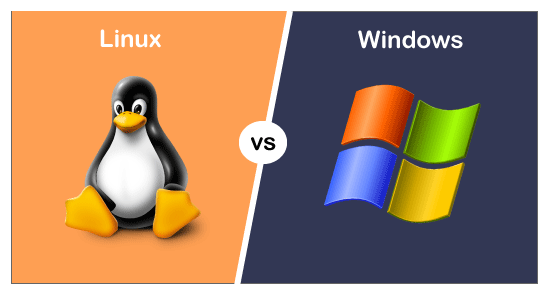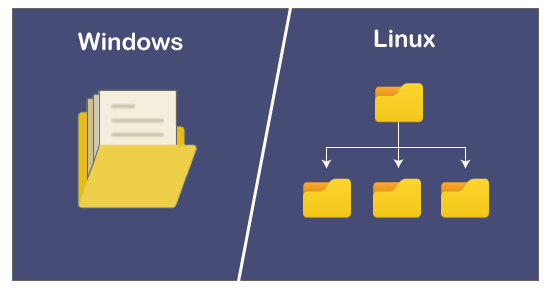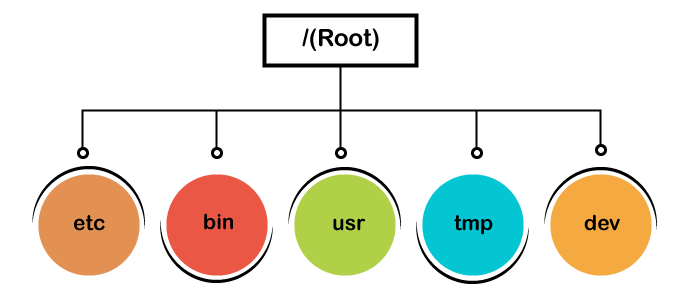Difference between Linux and Windows Operating SystemLinux vs. Windows has always been one of the most frequently asked questions related to the operating system. Users often get confused about which one is better for them. There is diversity between the users as most users prefer the graphical user interface (GUI) and most command-line interface (CLI). There are many disagreements and acrimonious behavior among users, and it seems that it will be forever. 
In this section, we will discuss the differences between Linux and Windows by considering several parameters such as performance, usability, security, ease of use, and more to clear a picture of using both operating systems. Further, we will see the advantages of Linux over other operating systems such as Windows and Mac OS. This will help you to decide which one is better for you. To understand the difference between Linux and Windows, let's see a brief introduction to both operating systems. Later we will talk on their features and security options. Windows Operating SystemWindows is a graphical operating system developed and marketed by Microsoft. It is also referred to as Microsoft Windows. Several versions of Windows have been introduced in the market; the current version is Windows 10. The first version of Windows was introduced on November 20, 1985, as a graphical operating system for MS-DOS. Microsoft Windows is a family of various operating systems. It comes with two versions, i.e., 64 bit and 32 bit. It facilitates both client and server versions. The latest client version is Windows 10, and the server version is Windows server 2019. Windows is a straight forward and simple to use. Generally, it is designed for users having no programming knowledge. So, mostly it is used for business and alternative industrial purposes.
The most recent release of Windows is Windows 11 for consumer tablets and PCs, Windows Server 2022 for servers, and Windows 11 Enterprise for corporations as of September 2022. Generations of Microsoft WindowsBy marketing role Microsoft has registered many trademarks, all of which represent the Windows operating system families that target a particular computing industry sector. The below Windows families were being developed as of 2014:
Windows OS FeaturesSeveral features of Windows OS are listed and explained below:
Linux Operating SystemLinux is an open-source operating system. As it is open-source, it is special and different from other operating systems, which means that you can customize it by editing source code. It provides programming as well as a graphical user interface. Linux is built by Linux Torvalds because he wanted to create a free operating system kernel that anyone can use. Linux is a collection of operating systems that are based on Linux kernel. The first version of Linux was released in the year 1991. The Linux system is most commonly used for servers; however, it is available in desktop versions as well. Ubuntu, Devian, and Fedora are some popular Linux distributions. Also, we have SUSE Linux Enterprise Server (SLES) and RedHat Enterprise Linux for the commercial distribution of Linux. As it is open-source, we can modify the source code and make variations in the operating system. Let's discuss some features and parameters to understand the difference between both operating systems:

Windows uses different drives such as C, D, E, and more, having some folders to store files. But Linux uses a tree structure to store and organize files. Linux file structure starts from the root directory, and it is considered as a start point of the file system. It is represented by a forward slash (/). In Linux, everything (Directories, devices, and files) is considered a file. There are three types of files available in a Linux system.
The general file system of Unix is as follows: 
General files: General files or ordinary files are files that contain images, text, or a program. These files are in ASCII text or Binary format. The General files are the most common in any Linux system. Directory files: Directory files are the depository for other files. A directory can have a subdirectory file within it. For Windows, we can understand them as folders. Device files: Windows represents the external devices (Pendrives, hard drives, and CD-ROM) as letters such as E: F: But, Linux represents devices as files, such as the hard drive's partitions are represented as dev/sda1, dev/sda2, and more (depends upon the number of partitions). All the device files take place within the directory /dev.
Linux files are case sensitive; therefore, we can have two files having the same name; one in upper case and other in lower case. Comparatively, the Windows files are not case sensitive; we cannot have two files with the same name.
Windows supports four types of users:
Comparatively, Linux supports three types of users:
Regular User In Linux, when we install ubuntu on our system, a regular account user is created. By default, all our files are saved in the home directory (/home/). A regular user cannot access the other user's directories. Root User Apart from the regular user account, a root user account is also created during installation. The root account is also called as superuser as it can access the restricted files, install the software and other utility, and has administrative rights. For installing the software or editing the system files or any other administrative task, we need the root access. For general tasks such as creating files, playing games, browsing the internet, we don't need the root access. Service user The Linux system is widely used as the server operating system. The leading service providers such as Apache, Squid, email, and more have their service accounts to increase security. Linux service user can allow or deny access to various resources depending on the service type. Note: The Ubuntu Desktop version does not have a service account, and the regular accounts are called standard accounts.
Linux OS has a separate home directory for a user. The files and directories created by a user are stored under a particular home directory. A user cannot store the files under any other user's directory, as it is not allowed to access the other user's directory. For example, the home directory of a user 'Alex' is automatically created as "/home/alex/" at the time of installation. The Windows OS also has different home directories for different users. It is as "C:\ documents or \settings."
Linux systems have a tree structure to save the directories; comparatively, Windows uses different drives to save the directories. In Windows, system and program files usually take place in C drive. But in Linux, the system and program files take place in their specific directory such as software files are stored in /bin, programs and device files are in /dev,and boot files are stored in /boot directory.
The basic part of any operating system is its kernel. It interacts with hardware devices and performs other functions such as process management, file handling, and more. Different operating systems have different kernels. Linux and Windows have a different kernel. The Linux kernel is monolithic, and it consumes more running space. Comparatively, Windows uses the microkernel, which consumes less running spaces. But, Windows running efficiency is less than Linux. The key difference between Linux kernel and Windows kernel is that Windows is a commercial software while Linux is open-source software.
Linux is an open-source operating system, so almost all the utilities and libraries are entirely free. The GNU/Linux distribution can be simply downloaded for free. However, some companies are providing paid support for their Linux distributions, but the underlying software is still free. Microsoft Windows licensed copy usually cost between $99.00 and $199.00. Microsoft currently stops providing support for the earlier versions. The latest version, Windows 10, is available at $139. Linux vs. WindowsLet's focus some head to head comparison between Linux and Windows.
Next TopicLinux Distributions
|
 For Videos Join Our Youtube Channel: Join Now
For Videos Join Our Youtube Channel: Join Now
Feedback
- Send your Feedback to [email protected]
Help Others, Please Share










